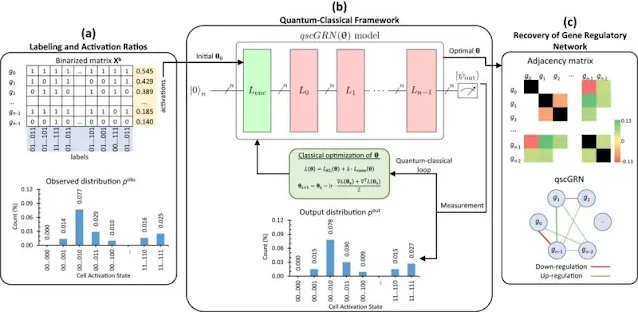Specialists use quantum figuring to foresee quality connections
In a new multidisciplinary study, specialists at Texas A&M College showed how quantum figuring — another sort of registering that can cycle extra kinds of information — can help with hereditary exploration and utilized it to find new connections between qualities that researchers were beforehand unfit to identify.
Their undertaking utilized the new processing innovation to plan quality administrative organizations (GRNs), which give data about how qualities can cause each other to initiate or deactivate.
As the group distributed in npj Quantum Data, quantum registering will help researchers all the more precisely anticipate connections between qualities, which could have immense ramifications for both creature and human medication.
"The GRN resembles a guide that lets us know what qualities mean for one another," Cai said. "For instance, in the event that one quality switches on or off, it might change another quality that could change three, or five, or 20 additional qualities down the line."
"Since our quantum processing GRNs are built in manners that permit us to catch more complicated connections between qualities than conventional registering, we discovered a few connections between qualities that individuals hadn't known about beforehand," he said. "A few scientists who work in the sort of cells we concentrated on read our paper and understood that our forecasts utilizing quantum processing fit their assumptions better than the customary model."
The capacity to know which qualities will influence different qualities is critical for researchers searching for ways of halting unsafe cell processes or advance supportive ones.
"In the event that you can anticipate quality articulation through the GRN and comprehend how those changes mean the condition of the cells, you could possibly control specific results," Cai said. "For instance, changing how one quality is communicated could wind up restraining the development of malignant growth cells."
Capitalizing on another innovation
With quantum registering, Cai and his group are defeating the constraints of more established processing advancements used to plan GRNs.
"Preceding utilizing quantum processing, the calculations could deal with looking at two qualities all at once," Cai said.
Cai made sense of that main contrasting qualities two by two could bring about deceiving ends, since qualities might work in additional complicated connections. For instance, if quality An enacts thus does quality B, it doesn't generally imply that quality An is liable for quality B's change. It very well may be quality C changing the two qualities, as a matter of fact.
"With conventional figuring, information is handled in bits, which just have two states — here and there, or 1 and 0," Cai said. "In any case, with quantum registering, you can have a state considered the superposition that is both here and there all the while. That gives us another sort of piece — the quantum bit, or qubit.
"As a result of superposition, I can reenact both the dynamic and latent states for a quality in the GRN, as well as this single quality's effect on different qualities," he said. "You end up with a more complete image of how qualities impact one another."
Making the following stride
While Cai and his group have endeavored to show that quantum figuring is useful to the biomedical field, there's still a great deal of work to be finished.
"It's an exceptionally new field," Cai said. "The vast majority working in quantum registering have a physical science foundation. What's more, individuals on the science side don't normally comprehend how quantum registering functions. You truly must have the option to figure out the two sides."
That is the reason the exploration group incorporates both biomedical researchers and specialists like Cai's Ph.D. understudy Cristhian Roman Vicharra, who is a vital individual from the examination group and initiated the concentrate behind the new distribution.
"Later on, we intend to contrast the sound cells with ones with infections or changes," Cai said. "We desire to perceive what a transformation could mean for qualities' states, articulation, frequencies, and so on."
For the present, it's vital to get as clear a comprehension as conceivable of how sound cells work prior to contrasting them with transformed or ailing cells.
"The initial step was to anticipate this benchmark model and see whether the organization we planned appeared to be legit," Cai said. "Presently, we can continue onward from that point."




![Android announcement [Episode -01] :: Android Rooting -1](https://blogger.googleusercontent.com/img/b/R29vZ2xl/AVvXsEhnegZW4O7k8wLFa_mdfvCZPRsDshoXtxSDi7jqhdk18Zw8ewJCFTKtLyoAjyDc5OMxrGjGWPwojm-Er0gYBA7XGpJWR3f849VpaWrQ04CaWLoyaioSik9FzhJJkbVBiNQsPHzcDP-rqQA/s72-c/00.jpg)




